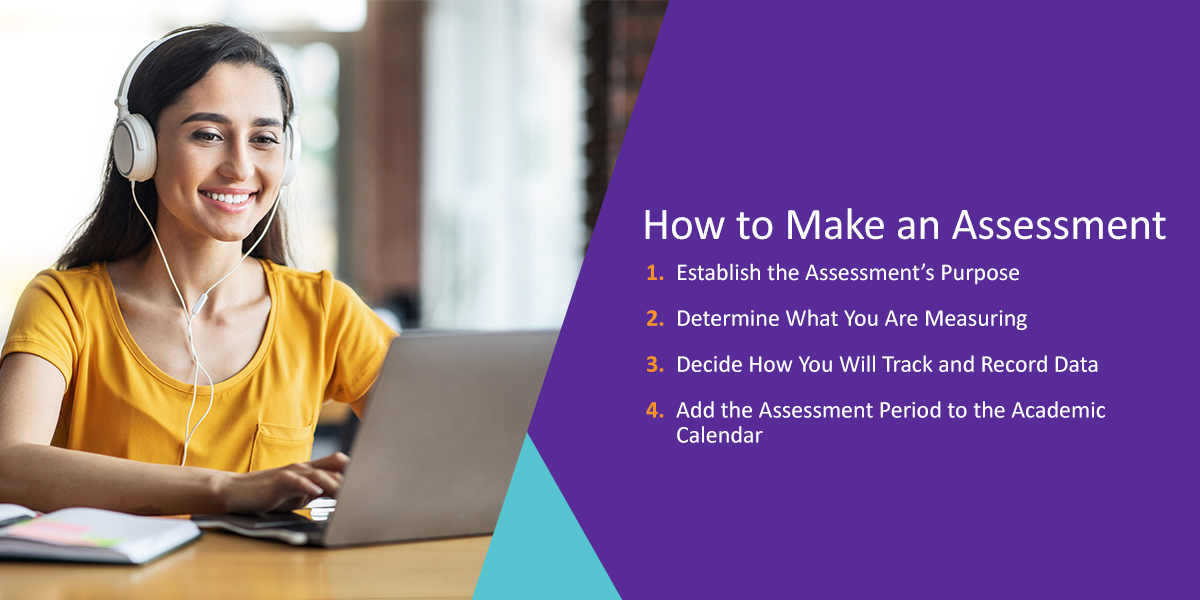Assessment entails much more than collecting and crunching data. It’s about using data to make informed decisions that facilitate continuous improvement. And accomplishing that requires a strong culture of assessment across campus — regardless of your institutional structure, location, or size.
Facilitating continuous improvement within a program or department (let alone across campus) is no small task. To this end, higher education institutions of every size share some common ground when establishing and sustaining a healthy culture of assessment.

What is an assessment?
Assessment of learning questions and answers helps higher education institutions measure their performance through data collection and review. Schools can use this information to support changes or apply for funding, such as through justifying a need for facilities, programs, and faculty. You can determine your needs and areas for improvement by collecting data from several sources on campus, including the following:
- Student population and demographics
- Staff demographics and retention rates
- Student learning and performance
- School culture
- Facilities
- Programs and curriculum
- Implemented technology and solutions
- Resources and tools
- Overall organization
You can use the data from these sources to drive significant campus improvements and changes that reflect your school’s needs and performance. With so many variables and outcomes, you can get many insights from the same data pool.
How to make an assessment
Since assessment processes can offer such comprehensive information, developing a strong assessment is vital. Understanding how to do so can help you optimize this internal process for all parties involved.
1. Establish the assessment purpose
The first essential step in implementing an assessment is determining why you need one. What are you aiming to learn or accomplish? Outlining and defining your assessment’s specific purpose early in development can help unify and direct efforts. You can ensure your administrators and faculty members all have the same mission and function in mind when carrying out processes later.
2. Determine what you are measuring
Once you know what you want to gain from your assessment, you need to determine which variables will deliver the results you need. For example, if you want to measure program preparedness, you might measure how quickly students get jobs after graduation.
When you understand what data you need to collect, you can determine where to direct assessment questions and efforts on campus.
3. Decide how you will track and record data
Your methodology should also include how you will collect and track your data. A centralized database is helpful for administrators and faculty members who need to access the data for analysis and reports, ensuring it is reliable and accurate. Actual collection methods might include rubrics that give assessment scorers simple ways to record responses and measure school performance.
4. Add the assessment period to the academic calendar
Assessment administration and preparation can be time-consuming, requiring meetings to discuss methods and strategies. Planning assessment times ensures that faculty and administrators have everything they need to conduct assessments and collect data while keeping the campaign’s main vision in sight.
As you approach your assessment period, consider adding it to the academic calendar for all professors, staff, and administrators to see. Increased awareness can guarantee that all parties are ready for upcoming requirements. They’ll have time to gather the information they need or ask questions before assessments release, streamlining the process for your assessment teams.
4 questions every campus should ask
Before all else, you need to understand where your culture stands now as a benchmark for determining where it should go. To help gauge the culture of assessment on your campus, start by answering these four questions:
1. Who is involved in assessment at your institution?
On your campus, you may already involve assessment practitioners, faculty, and students in assessment. But you should also consider adding other units like student affairs, libraries, and external stakeholders such as employers or alumni. Think about any constituencies who have any level of involvement with assessment, and engage them all. This brings unknown challenges to the surface, reinforces the value of collaborative assessment, and provides a consistent forum for ensuring all stakeholders can and do move forward in stride.
2. Are you sharing assessment results with stakeholders?
Many institutions host “Data Days” to share assessment findings internally with faculty and involve them in developing action plans to address areas needing improvement. It’s also becoming more common for institutions to share assessment results with students, parents, donors, and employers. While this may be a touchy subject on some campuses, the benefits of sharing findings and action plans with stakeholders far outweighs any perceived risk. Offering this kind of transparency builds credibility now, which facilitates deeper understanding of the rationale behind changes that may come.
3. Is there resistance to overcome?
After identifying and communicating assessment results with your stakeholders, sustaining that initial engagement is critical to overcoming potential resistance later on. You can proactively reinforce these valuable relationships in a positive way by staying focused on student learning, involving faculty in the identification of outcomes, encouraging collaboration within departments, and cultivating a culture of trust and support. Collectively striving toward the same goals will go a long way toward bridging many divides, perceived or otherwise, that can arise among the various ranks of stakeholders across campus.
4. Do your courses map to programmatic and institutional outcomes?
Individual course objectives should always align with program-level outcomes, which should map to institutional goals and strategic plans. By mapping outcomes in this way, your institution will be able to understand and demonstrate the relationships between them. This, in turn, helps pinpoint areas for deeper analysis to generate suggestions for improvement. Identifying and aligning outcomes also facilitates a shared understanding of assessment among stakeholder groups across campus. As mentioned previously, this common understanding is critical to building a strong culture of assessment.
Gauging your campus’ assessment culture is one of the first of many steps along the journey to continuous improvement. And you can’t get there alone. So know your stakeholders, engage them in a plan, collaborate early and often, and don’t be afraid to share how well you are doing — as well as where you need to improve.
As your journey continues and your culture of assessment matures, the path ahead will be illuminated by the lessons you learn along the way.
Track assessment data with solutions from Watermark
When preparing for assessment season, you can streamline processes and data collection with the right tools.
Our Planning & Self-Study solution streamlines the gathering, comprehending, reflecting, and acting on assessment data. Interactive dashboards provide transparency into assessment planning and outcomes achievement, and shared templates align your entire campus around strategic goals.
Watermark Course Evaluations & Surveys helps you turn student feedback into insights. Inspire curricular and program enhancements by including students’ feedback in your annual assessment cycles.
Another tool that can improve your assessment practices is Student Learning & Licensure. This solution helps you showcase the entire learning experience, from the classroom to the field. Embed rubrics to consistently measure progress on learning outcomes, incorporate artifacts from courses and field experiences using ePortfolios, and quickly compile evidence for accreditation using integrations and our innovative standards-based reporting.
Request a demo today and discover how Watermark can strengthen your school’s data use.
















































































































































































































































































































































































































